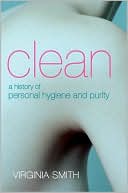

 |

|

The average rating for Clean: A History of Personal Hygiene and Purity based on 2 reviews is 2.5 stars.
Review # 1 was written on 2009-06-23 00:00:00 Lorraine Good Lorraine GoodThis fat little book was full of interesting tidbits, and as a bonus, I'm pretty sure my library copy has actaully been dropped IN THE BATHTUB at some point. I had been eagerly anticipating reading this, and although I certainly learned some new things, most of it was rather slow going...More academic than I had imagined. (Then, just when I had gotten used to the pace and exhaustive amount of detail, it practically fast-forwarded through the 20th century and I felt like the ending was quite abrupt.) |
Review # 2 was written on 2017-06-13 00:00:00 Mark Flavin Mark FlavinWhat a weird book. Smith makes downright odd assertions. For instance: "Elizabeth [Tudor] was known to be fussy about her health--she hated being ill" (189). Yeah, well, so do a lot of people. Or Louis XIV refused to bath but "was kept perfectly clean by his attendants, who continually rubbed him down with scented linen cloths, changed sweaty shirts at night, and changed his complete costume two or three times a day at least" (194). But being rubbed with a scented linen cloth won't get dirty dishes or dirty hair or a dirty armpit "perfectly clean." Or this: The overriding image of eighteenth-century Europe is one of supreme elegance: the perfect 'Quality' lifestyle of the aristocracy, gentry, and educated middle classes, for whom personal cleanliness and orderliness were now very visible marks of being 'genteel'. (226) Really? Has she never heard of the French revolution? All those people, cavorting in ridiculous powdered wigs crawling with lice, who are dispatched to the guillotine in their shifts? It's just so odd. Her discussion of "new age" ideas about health and hygiene in the US is completely off the mark in so many ways, as I can attest because I have witnessed it firsthand. Among other things, she talks about tanning as if she has never heard of skin cancer. Yes, there are still tanning salons in the world. There are also lots of people who won't go near them and wear sunscreen every single day. I did learn a few things--for instance, aristocratic women used fans to wave away bad air, thought to be a major source of contagion; that's why they were such a common accessory. Also, dresses got shorter at the beginning of the 20th century because "domestic science reformers criticized long hems that brushed in the dirt and dust, bringing potential disease from the street directly into the home" (300). And "eugenicists considered preventive medicine to be thwarting their aims by artificially prolonging the lives of the unfittest" (311), which I think probably helps explain why so many Republican law makers object to Medicaid: it keeps alive people they really believe should die. But that's not enough to justify reading the whole book. On the topic of purity, Purity and Danger: An Analysis of Concepts of Pollution and Taboo by Mary Douglas is far superior; on the topic of cleanliness, The Dirt on Clean: An Unsanitized History by Katherine Ashenburg is better. |
CAN'T FIND WHAT YOU'RE LOOKING FOR? CLICK HERE!!!